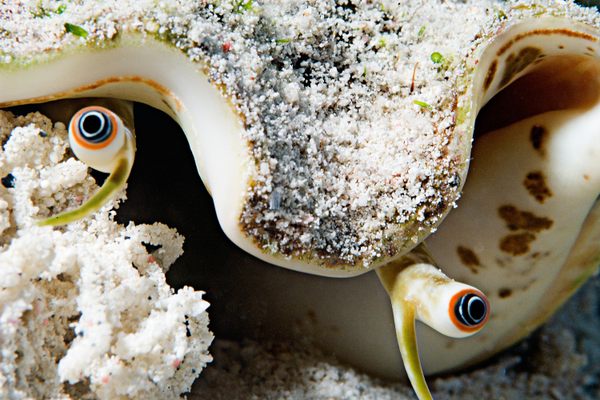A 10-Foot Long, 11,000-Year-Old Sponge Skeleton Has a Hidden Use
The “sponge record” can tell scientists about the climate of the past.

Deep down in the ocean, there lives a type of sponge that can grow close to 10 feet tall. This sponge, Monorhaphis chuni, belongs to the class of glass sponges, which have skeletons made with silicon. In some species of sponges, these skeletons grow as a fine, criss-crossing lattice. But M. chuni grows a single spicule that anchors it to the sea floor. Its softer body grows around this strong spine; the sponges look like giant, underwater reeds or large marine feathers, tethered to the ground.
For many years, scientists imagined that the deep ocean was empty of life. But after a telegraph cable was pulled from the ocean floor covered in marine creatures in 1860, scientific expeditions sailed around the world dredging the depths to find out what lived there. The Challenger expedition, which spent three years circumnavigating the globe, first discovered glass sponges in the 1870s; M. chuni was discovered during the Valdivia expedition, which lasted from 1898 to 1899 and looked even deeper in the ocean for life. Off the coast of East Africa, dredging to a depth of more than 5,000 feet, the expedition brought up one of its prize discoveries—an M. chuni spicule more than nine feet long. No other animal makes silicon structures as large as the spicules of M. Chuni.
Dating the spicules can be difficult. Sponges like these have lived in the oceans for millions of years; M. chuni are thought to have first evolved more than 650 million years ago, and individual sponges can live for millennia. Their spicules are made of hundreds of concentric layers of silica, gathered around an axial core. A cross-section can look a lot like concentric tree rings, but these layers don’t correspond to an exact time period in the same way that tree rings do. The make-up of those layers does have a close relationship with the temperature of the surrounding seawater, though, and by matching up those patterns, a team of scientists estimated the lifespan of one giant spicule, found in the East China Sea, to be 11,000 years old, plus or minus 3,000 years. (They published their results in a 2012 Chemical Geography paper.)

The longevity of these sponges make them a promising candidate for understanding the history of the deep sea and the planet’s climate going back thousands of years into the past. In the past 20 years, climate scientists have been researching the possible uses of sponges as proxies for long-term changes in the climate: The carbon values in shallow-water calcified sponges, for instance, have been shown to be a good indicator of carbon dioxide concentrations in the atmosphere. The deep past of the deep sea, though, has remained more mysterious.
In the 2012 paper, the team of researchers, based in China and Germany, proposed the possibility that M. chuni spicules could be a “paleoclimate archive,” which captured data about the climate of the distant past. Recently, in a paper published Geophysical Research Letters, a team led by the same scientists showed how the ratios of silicon and germanium in sponge spicules could document the changes of silica in the ocean during the last deglacial period.
The silicon available at different depths of the ocean depends in part on the lives and production of tiny algae, diatoms, which live closer to the ocean’s surface and suck up carbon dioxide as they photosynthesize. Silicon is a crucial nutrient in diatom life, and when they die, diatoms carry both carbon and silicon deeper down into the ocean. By looking at the changes in silicon and germanium ratios in the sponge spicules, it’s possible to better understand the long-term history of diatom production and its contribution to the global carbon cycle. These striking silicon spines, a wonder in their own right, hold secrets to the past that we’re just beginning to discover.























Follow us on Twitter to get the latest on the world's hidden wonders.
Like us on Facebook to get the latest on the world's hidden wonders.
Follow us on Twitter Like us on Facebook